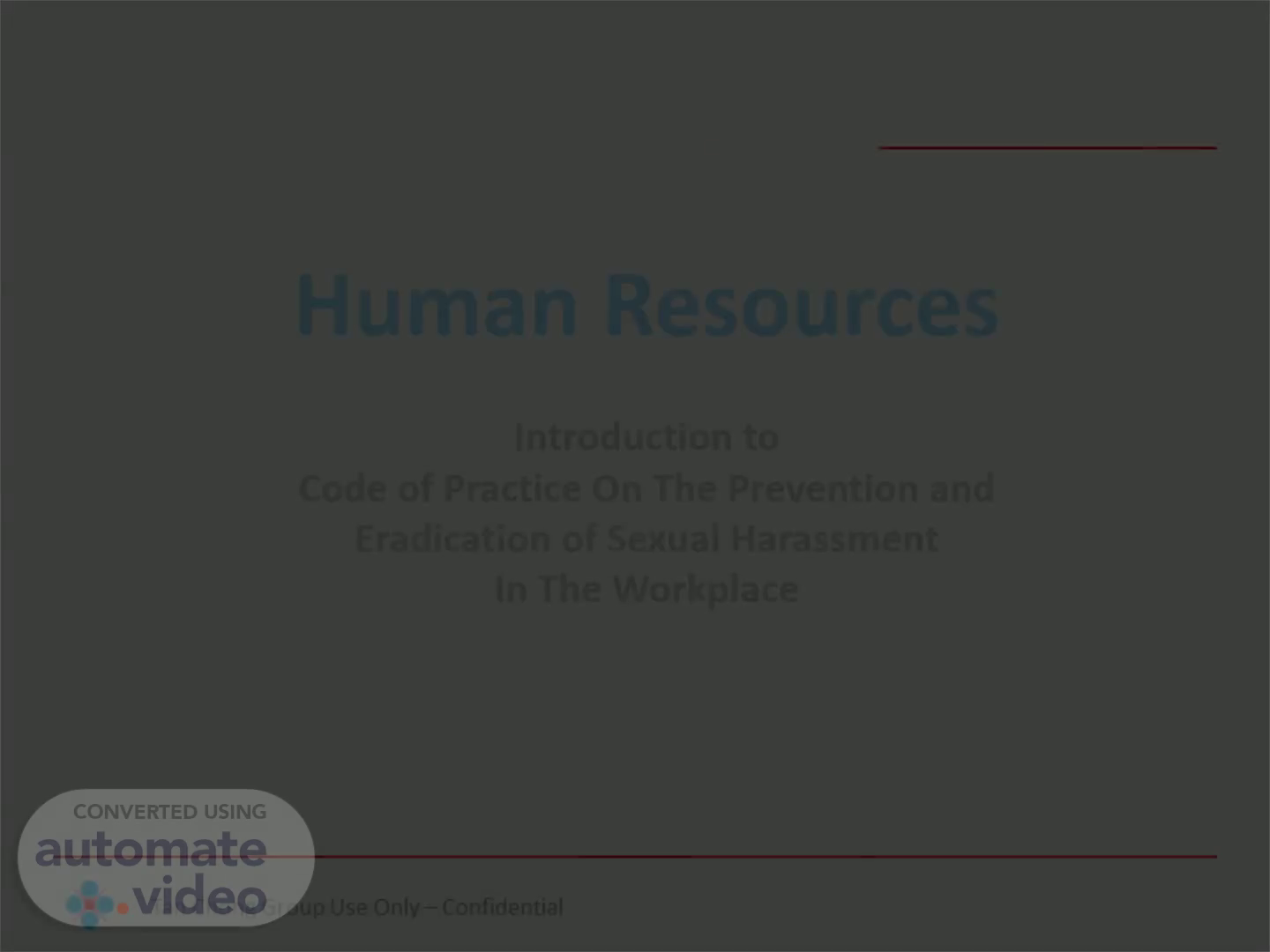Page 1 (0s)
11 Sept 2015. Human Resources. Human Resources Introduction to Code of Practice On The Prevention and Eradication of Sexual Harassment In The Workplace.
Page 2 (14s)
[Audio] Time for this section = 15- 20 minutes State: Now that you're familiar with the various types of harassment and how to respond when they occur, let's put this knowledge into practice. [based on how much time you have, you can do this one of two ways … Split participants into teams of equal number (or as close as possible). Provide 2- 3 scenarios for each team (there are a total of 10), depending on the number of teams. You may also go through exercise as one large group] State: We're going to divide into several teams. Each team will be given 2-3 scenarios that depict a possible situation harassment. Each scenario will have some questions for you to answer. You'll want to particularly ask yourself: Can this situation be considered unlawful harassment? What type? How would you respond? In each scenario YOU are the Leader! Ask: Are there any questions on what you are suppose to do? [wait for response] State: You will have 15 minutes. [At the end of 15 minutes have each team present their findings to the larger group. Provide opportunity for discussion. Reinforce correct answers and add any points missed in the scenario].
Page 3 (1m 47s)
[Audio] Scenario # 2 You're having coffee with Marcie, who reported to you until a recent transfer. Marcie shares with you, in confidentially, that a co-worker has been pressuring her for a date. She's told him no, but he persists. It is starting to become uncomfortable. You ask Marcie if she has reported it. Marcie says she has not. She tells you she really doesn't want anyone else to know, and it shouldn't go any further. Question: As a leader, what would be the best solution regarding Marcie's conversation with you? Let Marcie know you will keep it confidential as much as possible but you are required to act upon it. Actions might include: Encourage Marcie to tell her manager If Marcie doesn't want to address the issue with her leader tell her you need to report it to HR or her leader yourself Further clarification The company now has knowledge through the supervisor, and you must follow company policy. Respecting the confidential conversation between two people is important. However, leaders in the company are obligated to take action. Although every effort will be made to safeguard confidentiality, leaders should make it clear that they are legally required to act when informed that a harassing situation exists. It may also be impossible to conduct a thorough investigation without revealing certain information to the alleged harasser and potential witnesses. If you know, the company knows..
Page 4 (3m 30s)
[Audio] Scenario # 3 An employee in field sales has informed you she feels sexually harassed by a key dealer salesperson. It is making her uncomfortable and she wants it addressed. In order to avoid jeopardizing the relationship with this dealer you thought it best to reassign her to a different dealership. Have you taken appropriate action in addressing this complaint? No, you haven't met the obligation to investigate and address the situation. Employers are liable for harm caused by coworker and non-employees. Other employees are still faced with the potential exposure to ongoing harassment by this individual Reassigning the employee would likely be viewed as punitive to her and may raise a claim of retaliation. What action might you have taken? Investigate the situation more thoroughly in collaboration with the dealership Make sure appropriate corrective action is administered by the dealership and the harassment has stopped Leave her assigned to the account unless she requests to be re-assigned.
Page 5 (4m 41s)
[Audio] Time for this slide = 3 minutes Read Scenario: Mel is an employee in his late 50's. He has started working with a new data research team. The team is delegating tasks for the project. Mel has volunteered to take responsibility for one of the tasks – developing a data matrix but the task was assigned to a younger team member. Cue audio or ask: I need four volunteers to read the script? [ 4 volunteers – 2 men, 2 women] [hand out script cards] State: Let's hear how that dialogue went… [If reading script, assign roles and have volunteers read script – or play audio] Rachel: The last task that needs to be assigned is developing a data matrix. Who's willing to take responsibility for this? Mel: That's something I can do. My work load's a little light right now. I could use the extra work. Mark: Are you sure you want to do that Mel? It's going to be a lot of work. Shouldn't you be taking it easy at this point in your career? You know…coasting to retirement? Rhonda: Yeah…besides, it might be better if someone in our age group handled this project considering your age group isn't as computer savvy. [end audio] Ask: What type of harassment is this? Why? [wait for response, then ask why. discuss if necessary] State Response: In this situation Mel is frustrated and angry that his age is viewed as a disadvantage rather than as an advantage of providing experience and insight. He was not given the opportunity to work on certain projects because of his age. Ageism is a type of harassment / discrimination where negative comments or actions are made regarding an employee's age when referring to employees 40 and over. Denying an employee opportunities because of age is one example of discrimination. » » [ number on script card matches screen].
Page 6 (7m 12s)
[Audio] [ number on script card matches screen]. 6.
Page 7 (7m 33s)
A Clear definition of Sexual Harassment A complaint/grievance procedures Disciplinary rules & penalties against harasser & false accusation Protective & remedial measures for victim Promotional & educational programs.
